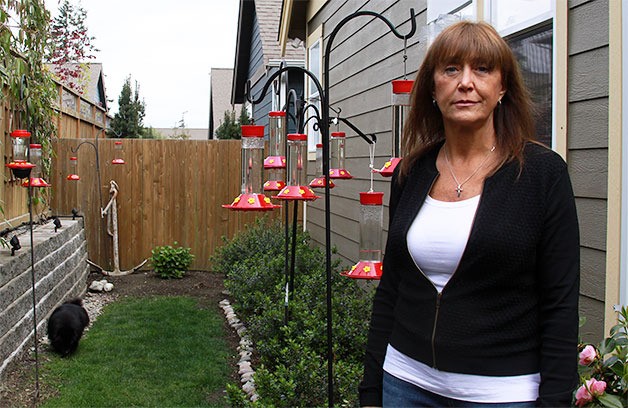When her dog showed up at the back porch with a dead bird in its mouth, LaDonna Richardson didn’t get overly concerned.
But when 15 more birds died over a four-day span in her Oak Harbor backyard last week, Richardson was left almost speechless.
“It was so sad,” she said. “I watched three of them die right in front of me. They would just fall over.”
Richardson reported the mass die-off of 15 American goldfinches and one dove to biologist Ruth Milner of the Washington Department of Fish and Wildlife and was told the cause pointed to a strain of salmonella bacteria.
Milner said it’s not uncommon to get a few reports a year of dead birds, particularly finches, from salmonella. The bacteria is often spread at birdfeeders when feces from infected birds gets in contact with the seed and is ingested.
Chances of contamination increase when too many birds concentrate at the same feeders.
“It’s in the environment naturally, and when birds concentrate at feeders, they contract the bacteria and spread it to others,” Milner said.
“Feeders attract birds in greater numbers to one spot than would occur naturally in the wild, so we see several fatalities at one time as we are seeing in Oak Harbor.”
Milner, who handles such cases in Island County, hasn’t received other reports on Whidbey so far this spring and believes this case to be isolated to feeders in Richardson’s Fairway Point neighborhood.
Birds are able to fly through a narrow backyard corridor of homes on Richardson’s street, landing in the most appealing places.
Richardson’s backyard is small but inviting to birds with its water fountain, maple tree, shade and an abundance of feeders.
Like so many other bird lovers, Richardson said she and her fiancé enjoy the birds, and she regularly cleans her feeders to try to help prevent any illnesses.
“Maybe not everybody is cleaning their feeders as diligently as others,” Richardson said.
Milner said it’s critical to use a 10 percent solution of bleach when cleaning the feeders and advises cleaning them once a week.
It’s also important to clean up the seed waste under the feeders. Finches, in particular, like to sift through the seed on the ground.
Milner’s best advice for the warmer months, however, is to take the feeders down.
“We all love to see birds,” she said. “Feeders are a great way to attract them to the yard. But it’s not necessary for their survival.
“We don’t need to be feeding them this time of year. There’s a lot of food coming on line.”
David Parent, a longtime veterinarian, understands the conundrum.
“I’m not so sure if we’re saving more birds at feeders,” said Parent, who works at Useless Bay Animal Clinic in Freeland.
“Sick birds are going to concentrate around places where there’s easy food like feeders.”
Parent said winter feeding makes more sense.
“I think the bottom line is, by feeding birds in the winter time, we get enjoyment out of it,” he said. “And I think we probably help more through the winter than that die because we’re feeding them.”
Richardson followed Milner’s advise and took down her birdseed feeders and hasn’t seen a sick or dead bird in her yard since last week. She wonders if the sickened birds just came to her tranquil yard to die.
The sick ones she saw were puffy, lethargic and appeared to have lost their fear of humans. Some suffered from diarrhea.
“If it’s salmonella and they’re acting sick, they’re probably going to die,” Parent said. “We’ve never been able to pull one out of that. It’s a bad deal. Birds are prey animals. They don’t show that their sick until they’re really sick. A sick animal gets picked off by predators. Once people can walk up to one and pick one up, they’ve already got one foot in the grave.”
Richardson said she was told her hummingbird feeders could remain since the sweet liquid the birds drink isn’t exposed. She said she also cleans those feeders regularly.
More than a dozen hummingbirds buzzed through her backyard Wednesday, zig-zagging from one feeder to the next.
“It goes on all day long,” Richardson said.
“It’s like a runway here. They sound like bees.”



